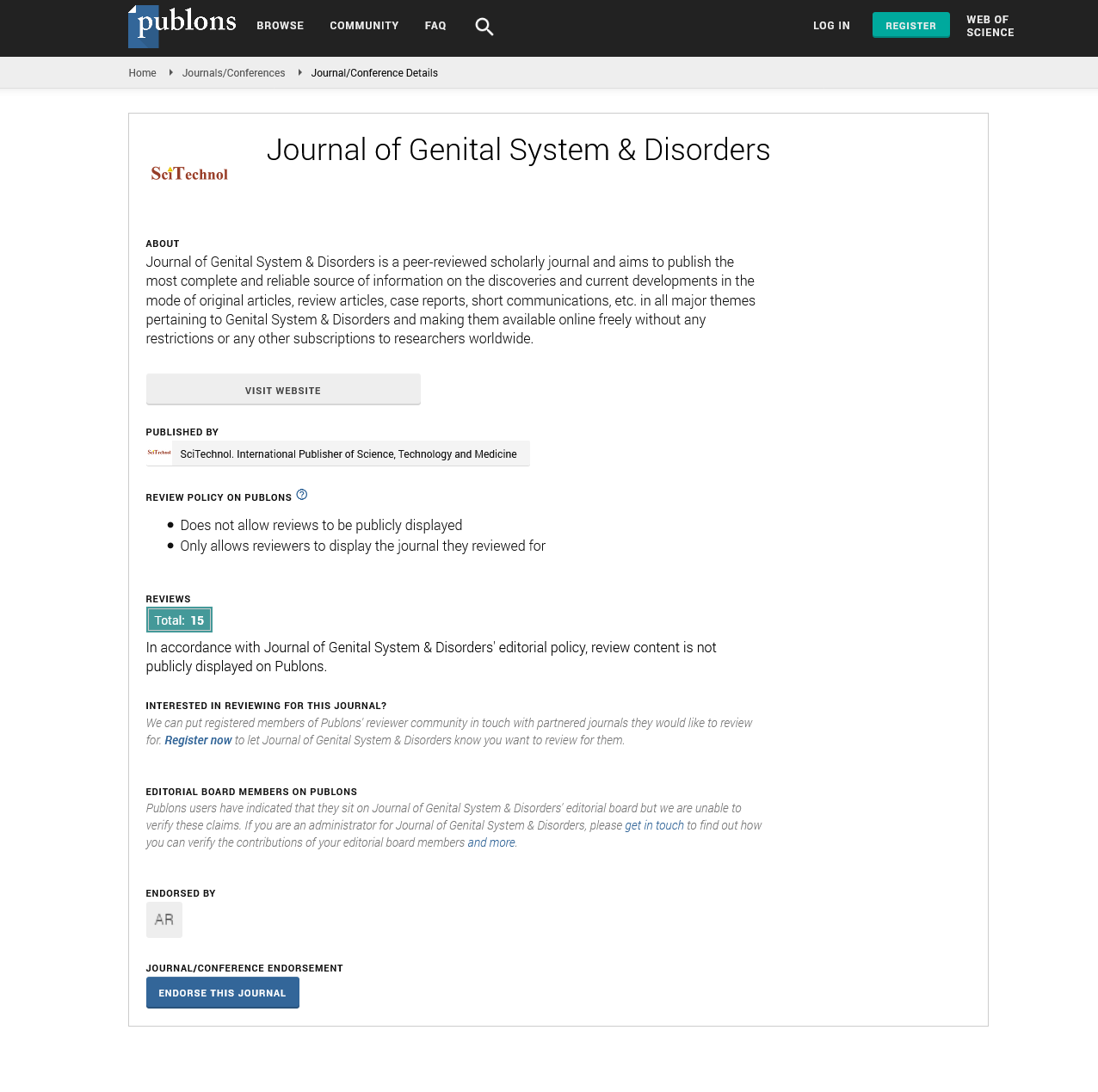Perspective, Vol: 14 Issue: 1
Role of Mitochondrial Biochemistry in Oocyte Quality and Reproductive Success
Michael Brown*
Department of Reproductive Biology, Institute of Reproductive Biology, Johns Hopkins University, Maryland, United States
*Corresponding Author: Michael Brown
Department of Reproductive Biology, Institute of Reproductive Biology, Johns Hopkins University, Maryland, United States;
E-mail: Mariagarcia@su.edu
Received date: 02 March, 2024, Manuscript No. JGSD-24-128699;
Editor assigned date: 04 March, 2024, QC No. JGSD-24-128699 (PQ);
Reviewed date: 18 March, 2024, QC No. JGSD-24-128699;
Revised date: 03 March, 2025, Manuscript No. JGSD-24-128699 (R);
Published date: 10 March, 2025, DOI: 10.4172/2325-9728.1000283
Citation: Brown M (2025) Role of Mitochondrial Biochemistry in Oocyte Quality and Reproductive Success. J Genit Syst Disord 14:1
Description
The intricate connection between mitochondrial function and fertility has been a subject of intense interest and investigation in the field of reproductive biology. Mitochondria often referred to as the cellular powerhouses, play a crucial role in oocyte quality and overall reproductive success. This article delves into the fascinating world of mitochondrial biochemistry and its impact on female fertility, highlighting key research findings and potential implications for reproductive health.
Mitochondria are essential organelles found in eukaryotic cells, including oocytes. They are responsible for producing Adenosine Triphosphate (ATP), the primary energy currency of the cell. However, mitochondria are not solely energy generators; they are also involved in a diverse range of cellular processes, including calcium homeostasis, apoptosis regulation, and the synthesis of important biomolecules. In the context of oocyte quality and fertility, mitochondria play a pivotal role in providing the necessary energy for oocyte maturation, fertilization, and early embryonic development.
Research has elucidated the impact of mitochondrial function on oocyte quality, with particular emphasis on mitochondrial DNA (mtDNA) integrity, quantity, and bio-energetic capacity. Mitochondrial biochemistry can influence oocyte quality through various mechanisms, including ATP production, Reactive Oxygen Species (ROS) generation, and the maintenance of optimal redox balance. Dysfunction in mitochondrial bioenergetics and increased oxidative stress within the oocyte can lead to compromised developmental potential and reduced fertility.
Furthermore, the transmission of mtDNA from the oocyte to the offspring has garnered significant attention in reproductive biology. Mitochondrial genetics can influence various aspects of reproductive success, including embryonic development, implantation, and pregnancy outcomes. Mitochondrial DNA abnormalities or mutations have been associated with reproductive disorders and infertility, highlighting the intricate link between mitochondrial biochemistry and female fertility.
Recent advancements in technology have enabled researchers to delve deeper into the molecular intricacies of mitochondrial function and its impact on oocyte quality. Cutting-edge techniques, such as live-cell imaging, mitochondrial DNA sequencing, and metabolomic analyses, have facilitated a more comprehensive understanding of the role of mitochondria in female reproductive health. By dissecting the nuances of mitochondrial biochemistry, scientists aim to identify potential biomarkers of oocyte quality and develop novel therapeutic strategies to enhance fertility outcomes.
The exploration of mitochondrial function in the context of fertility is not limited to basic science research; it has significant clinical implications. Understanding the molecular underpinnings of mitochondrial bioenergetics and its impact on oocyte quality can inform Assisted Reproductive Technologies (ART) and personalized fertility treatment approaches. Mitochondrial supplementation techniques, mitochondrial transfer, and mitochondria-targeted antioxidants are among the emerging interventions that hold promise for improving reproductive outcomes in individuals facing fertility challenges.
Moreover, the influence of environmental factors and lifestyle choices on mitochondrial function and female fertility cannot be overlooked. External stressors, such as oxidative damage from environmental toxins, aging, and unhealthy dietary habits, can detrimentally affect mitochondrial bioenergetics and contribute to oocyte dysfunction. By recognizing the interplay between environmental factors, mitochondrial health, and reproductive success, clinicians and researchers can advocate for holistic approaches to fertility management and promote mitochondrial wellness in individuals planning for pregnancy.
In conclusion, the realm of mitochondrial function in relation to oocyte quality and reproductive success is a captivating landscape that intertwines biochemistry, genetics, and clinical practice. The intricate dance of mitochondria within the oocyte orchestrates the symphony of fertility, encompassing energy provision, redox balance, and genetic legacy. As research continues to unravel the molecular intricacies of mitochondrial biochemistry, its implications for fertility and reproductive health present an exciting avenue for innovation and personalized care. The quest to harness the power of mitochondria for enhancing female fertility stands at the forefront of scientific inquiry, offering hope and possibilities for individuals aspiring to build their families.
 Spanish
Spanish  Chinese
Chinese  Russian
Russian  German
German  French
French  Japanese
Japanese  Portuguese
Portuguese  Hindi
Hindi 
